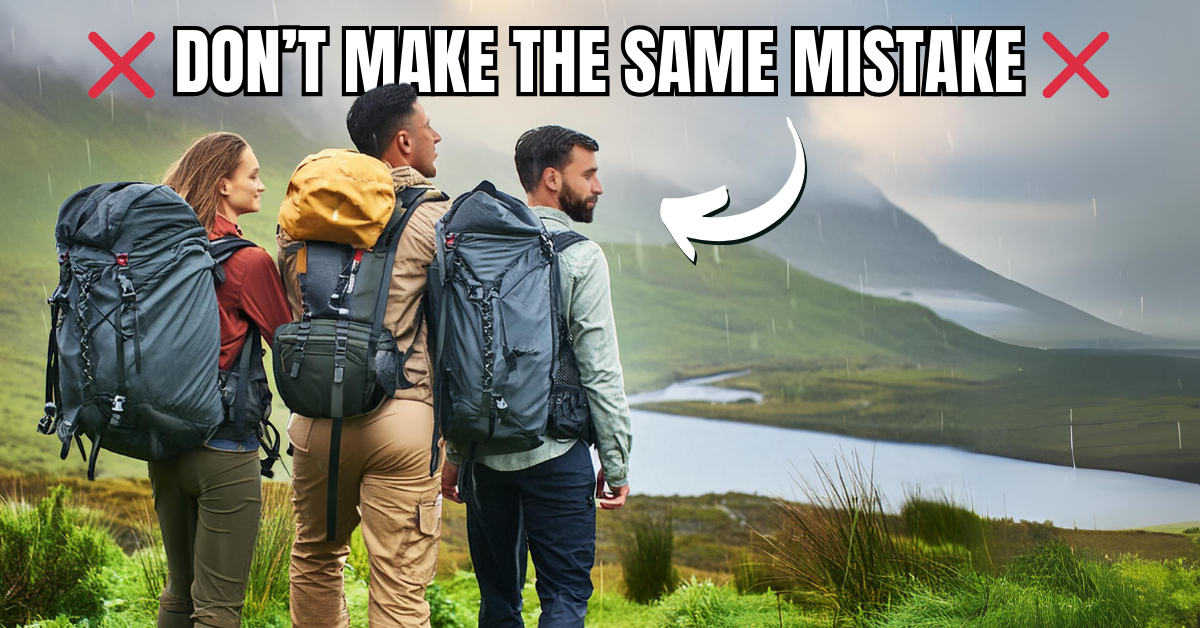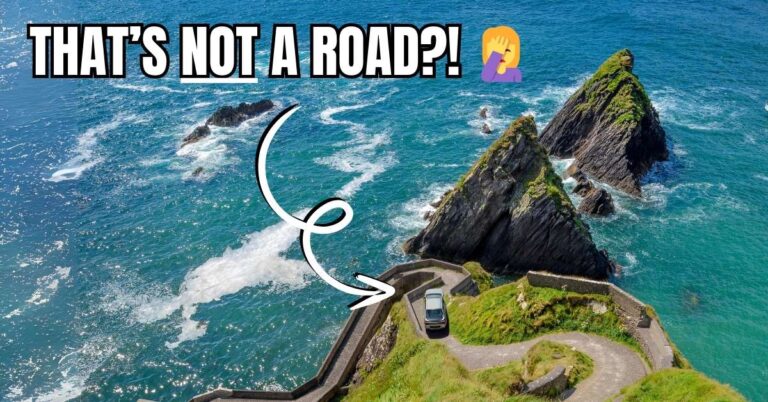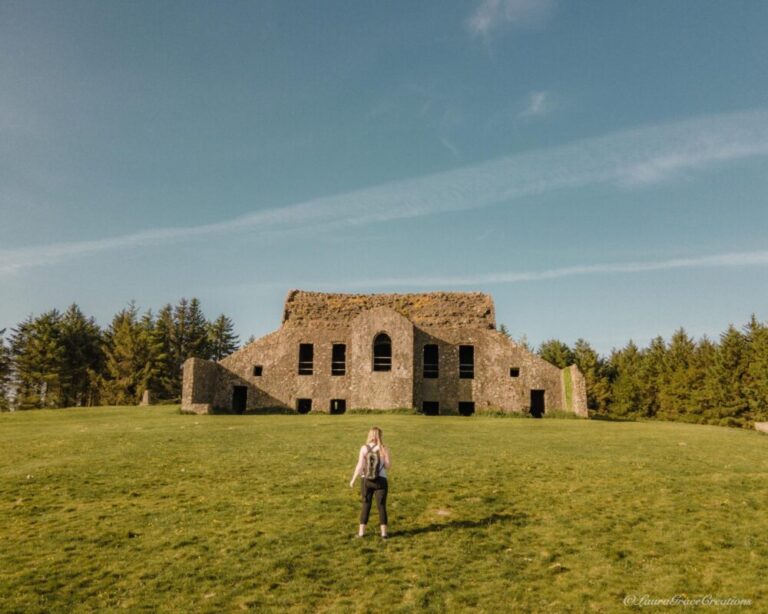Avoid picking the WORST time to visit Ireland…(a locals guide)
Ireland Travel Planning contains affiliate links and is a member of the Amazon Services LLC Associates Program. If you make a purchase using one of these links, I may receive compensation at no extra cost to you. See my Disclosure Policy for more information. Ireland Travel Planning also uses both personal and paid stock photos to illustate posts
Is there actually a ‘best time to visit Ireland'?
Are some months just worse than others?
Personally, I don’t particularly like February…and ironically it’s my birthday month.
The weather is cold, the days are short and there is pretty much nothing exciting happening…
And unfortunately it is not the only month of the year that gets a bad rep when it comes to Ireland travel…
That’s why I sought out to help, I have created the ULTIMATE guide on the best time to visit Ireland based on your own particular travel style and preference.
So, whether you are an all day adventure lover who wants to stay out exploring to 10pm or you prefer the cozy vibes and in bed by 9. There is a perfect month for you. And post will help you find it!
Quick Break Down: The Best Months Are…
Ok, so if I had to choose just three months to visit Ireland I would more than likely go with September or April for those who love spending time outdoors in nature. I think the Irish landscapes are at there prettiest throughout these months and the days are long enough to go on multiple adventures.
I'd choose December for those looking to stay nice and toastie by a fire. The Christmas lights give the street a wholesome feel and everyone is celebrating the holidays. The pubs are at there best at this time of year!
If you are looking for a little bit more information on what other months may tickle your fancy than that then advise you keep on reading.
Before you visit Ireland, here's some quick recommendations…
📞 International roaming can be expensive, honestly eSims are the way to go! Airalo offers some pretty affordable cell phone plans that work seamlessly across Ireland, this one is best for travel within the Republic of Ireland and these deals work in both the Republic and Northern Ireland.
🏨 Hotel prices can go up and down, I always like to compare pricing by using site such as Booking.com or Hotels.com
🚌 Actives and Experiences is what makes an Ireland trip that extra bit special! Like did you know you can design your own Claddagh Ring? (one of my favourites). I typically find the best experiences by using the likes of GetYourGuide or Viator.
🚘 Renting a car is one of the best ways to explore the beauty of Ireland, but the pricing can be very competitive, that's why it is always best to check out site like Discover Cars to compare rental prices.
✈️ You never know what airlines may be offering Ireland flight deals, they can go down by 100's in a day, I always like to turn on price tracker on Skyscanner so I never miss a deal!
🏥 I can't stress this enough but travel insurance is an absolute must! Thankfully SafetyWing have some pretty affordable plans.
January & February in Ireland: The Pros & Cons
Being the first two months of the year, it can be quite nice to kick things off with a little trip away but the question is, should that trip be too Ireland? There definitely are some positives to visiting Ireland in January or February but personally I probably wouldn't. Let me explain why…
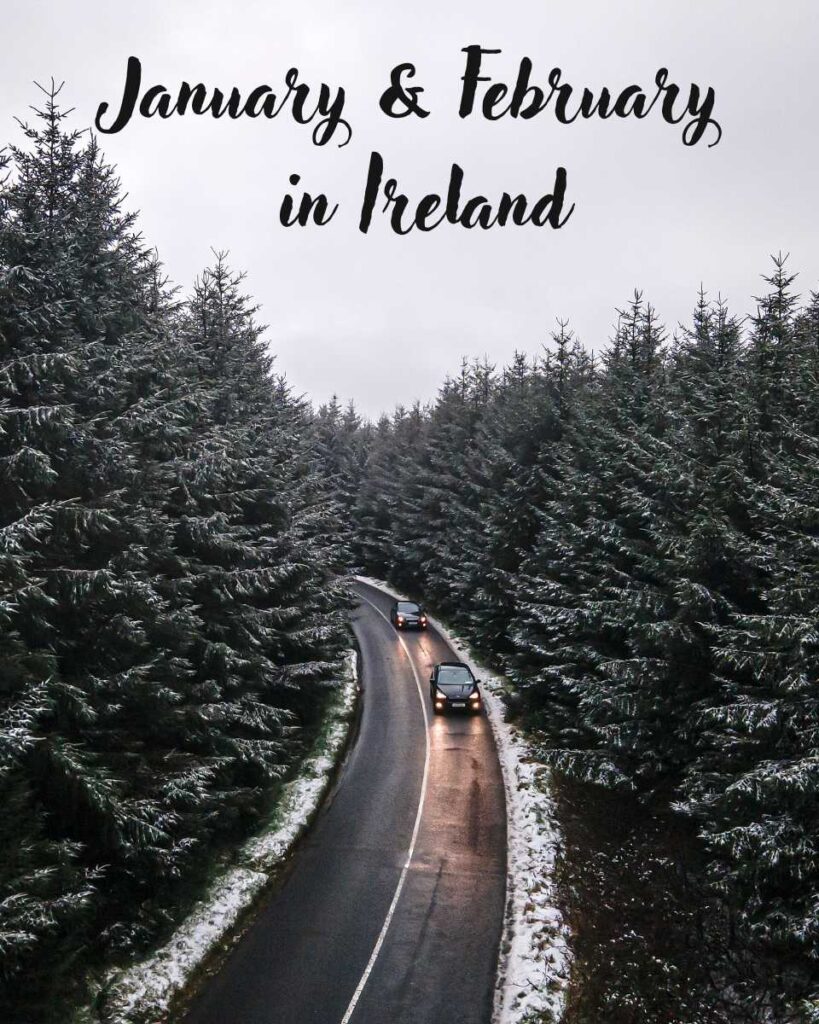
For starters the weather…
Typically at this time of year the weather is a cold, damp and windy.
The temperatures can range from -2°C to 7°C (28.4°F to 45°F). And the wind chill can make seem even colder.
And it can be common to experience snow, sleet and hail storms.
Then you have day light hours…
They're limited, the sun tends to set before 4.30pm meaning there is only 7-8 hours of sunlight in a day and that's providing you are out the door by 8am.
This is something tourists do not consider when planning out their itinerary. Most Ireland travel guides are written with the summer months in mind. So, it is easy to miss out on things simply because it got dark before you arrived.
And A LOT of attractions close in the winter months…
Yes, I know February is technically ‘spring' but why does it give off such winter vibes then? If you are planning on travelling along Ireland's Wild Atlantic Way then be prepared for a range of closers. For example, the Aran Islands, Mizen Head and various boat tours. Ireland also tends to be on the quite side at this time of year. Everyone is broke after the holidays and that ‘buzz' we are known for is very much hidden. The pubs are nowhere near as busy as people try to save for the year ahead.
✅ Pros to visiting Ireland in January & February
Now with all being said, if this is the only time you can visit Ireland there are many pros that come with it.
First, lets talk about the crowd levels. There is very little. Which means you can have places like the Cliffs of Moher and the Giants Causeway all to yourself.
Your vacation will also be far more affordable, with deals on flights, hotels and attractions being common around this time period.
🫢 Things to do in Ireland in January & February
To be honest, apart from New Years celebrations there is very little things to do in Ireland at this time of year. The Christmas lights typically stay up until the 6th of January so planning your trip around this time would definitely be the most desirable.
Then we have pancake Tuesday for avid pancake fans out there, but I'm not sure that can count as a ‘reason' to visit Ireland considering it is nothing special or unique to the country.
The main attractions such as the Cliffs of Moher, Giants Causeway and Guinness Storehouse will still be open. And the crowd levels will be far less which is quite enjoyable.
🎒 What to pack for Ireland in January & February
The most important thing to pack for Ireland at any time of year is warm clothing. Let's just say you will need LOTS and LOTS of layers. Think along the lines of coats, sweaters, thermals and a waterproof jacket.
Foot ware is also an important thing to consider before your trip, you will want something waterproof. I am particularly fond my hiking boots. They keep my feet nice and warm, dry and are so comfortable.
I'd also advise packing a good pair of warm accessories, such as hats, scarfs and gloves. If your hands tends to feel the cold more I'd advise thermal gloves like these or hand warmers! These saved me on a cold winter van trip in Clare.
Need with your Ireland trip? Let me be your guide…
🙋♀️ Travel Consultation
Book a 40 minute Ireland Travel Planning call with Laura your local guide to discuss some insider tips for your Ireland vacation!
🇮🇪 Free Resources
Explore my free resources packed with insider tips and expert knowledge to help you plan your trip to Ireland!
😘 Say Thank You
Finding my content helpful? A small tip would mean the world to me. It helps me to continue making these free guides 💛
Or, Join my FREE Ireland Travel Planning Facebook Group to ask questions about your upcoming trip! I pop in once a week to answer as manny as possible 🇮🇪
Need with your Ireland trip? Let me be your guide…
🙋♀️ Travel Consultation: Book a 40 minute Ireland Travel Planning call with Laura your local guide to discuss some insider tips for your Ireland vacation!
🇮🇪 Free Resources: Explore my free resources packed with insider tips and expert knowledge to help you plan your trip to Ireland!
😘 Say Thank You: Finding my content helpful? A small tip would mean the world to me. It helps me to continue making these free guides 💛
ℹ️ Join my FREE Ireland Travel Planning Facebook Group to ask questions about your upcoming trip! I pop in once a week to answer as manny as possible 🇮🇪
March & April in Ireland: The Pros & Cons
As we move into March and April, the question arises: is this a good time to visit Ireland? The simple answer is yes, but let’s dive into why these spring months might be the perfect time for your trip—or not!
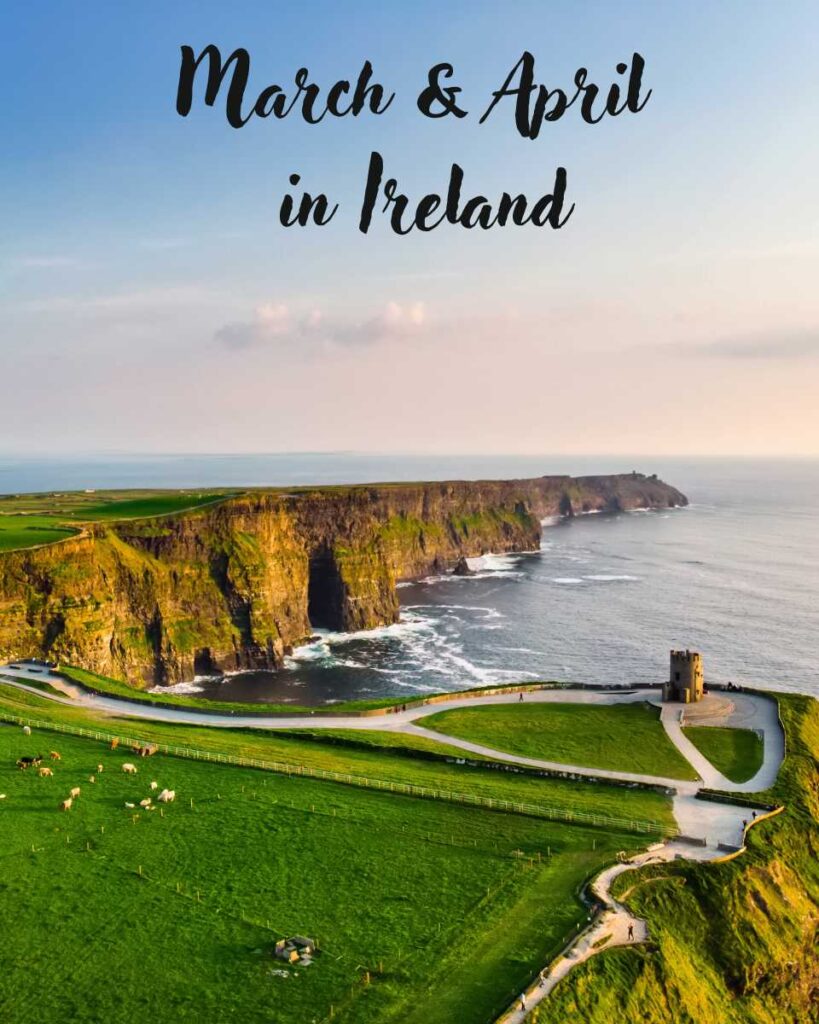
First, let's talk about the weather…
March in Ireland is still on the chilly side, with temperatures ranging from 4°C to 10°C (39°F to 50°F).
You’ll definitely want to bring a warm coat and those trusty layers. But by April, things start to warm up a bit, with temperatures often reaching up to 13°C (55°F) on a good day.
The rain is still a constant companion, but you'll notice that the days are gradually getting longer, giving you more daylight to explore.
And speaking of daylight…
March sees the days getting noticeably longer. By the end of the month, the sun doesn’t set until around 7:30 pm, which gives you about 12 hours of daylight to enjoy. April is even better, with sunset not until after 8:30 pm, so you’ll have plenty of time to fit in all the sights on your itinerary.
Crowds start to return…
While March is still relatively quiet, with fewer tourists compared to the summer months, April marks the beginning of the tourist season in Ireland. You’ll start to see more people at popular attractions, but nothing compared to the peak summer crowds. This can be a great time to visit if you prefer a balance between quiet and lively.
✅ Pros to visiting Ireland in March & April
One of the best things about visiting Ireland in March and April is the sense of renewal in the air. The landscape comes alive with vibrant greens, and you might even catch some early blooming flowers. It’s a great time for hiking, as the trails are less muddy than in winter, and the fresh spring air is invigorating.
St. Patrick’s Day in March is, of course, a massive draw. Celebrations are held across the country, with parades, music, and a festive atmosphere that you won’t find at any other time of year. If you’re in Ireland on March 17th, prepare to be swept up in the national pride and general merriment.
🫢 Things to do in Ireland in March & April
March and April offer plenty of activities and attractions that are either reopening after winter or are best enjoyed in the spring. Beyond the famous St. Patrick’s Day celebrations in Dublin, you can explore the beauty of Killarney National Park as it begins to wake up from its winter slumber.
If you’re a fan of festivals, April is a great time to visit as well. The Galway Food Festival usually takes place around Easter, offering a taste of the local culinary scene. Also, the Dublin Bay Prawn Festival in Howth is a seafood lover’s dream.
The longer days mean you can comfortably plan a visit to the Cliffs of Moher or the Ring of Kerry without worrying about running out of daylight. The weather might still be unpredictable, but that's all part of the Irish experience!
🎒 What to pack for Ireland in March & April
When packing for Ireland in March and April, think layers, layers, and more layers! The weather can change quickly, so be prepared for everything from sunshine to sudden rain showers. A good waterproof jacket is a must, and don’t forget your comfortable, waterproof footwear for those scenic walks.
You’ll also want to pack some lighter clothing for the warmer days, but keep those hats and scarves handy for cooler mornings and evenings. And, of course, no trip to Ireland is complete without a reliable umbrella—just in case!
May & June in Ireland: The Pros & Cons
As spring gives way to early summer, May and June offer some of the best conditions for a visit to Ireland. But are they the right months for you? Let’s take a closer look at what you can expect.
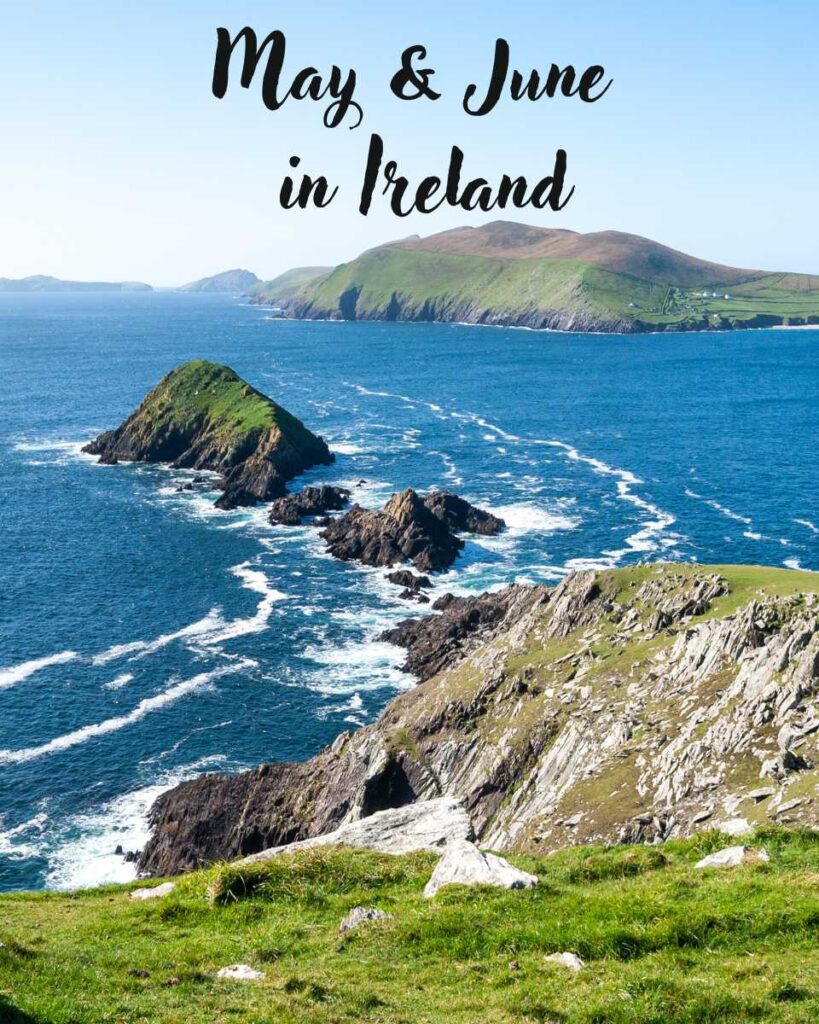
First, let's talk about the weather…
May marks the beginning of warmer weather, with temperatures ranging from 8°C to 15°C (46°F to 59°F).
By June, you can expect even milder conditions, with temperatures reaching up to 18°C (64°F).
Rain is still part of the deal—it is Ireland, after all—but you’ll also experience more dry and sunny days, making it ideal for outdoor activities.
And speaking of daylight…
If you love long days, you’ll adore May and June in Ireland. By May, the sun doesn’t set until after 9:30 pm, giving you about 16 hours of daylight. June takes it a step further, with daylight stretching until nearly 10 pm. This is perfect for those who want to pack as much sightseeing as possible into each day.
Crowd levels increase…
May sees the start of the tourist season, but it’s still relatively calm compared to the busy summer months. By June, however, the crowds are noticeably larger, especially at popular attractions like the Cliffs of Moher and Dublin’s Temple Bar. While this means a livelier atmosphere, it also means you’ll need to plan ahead for accommodations and tours.
✅ Pros to visiting Ireland in May & June
May and June are fantastic months to visit Ireland if you’re looking for a mix of good weather, long days, and plenty of things to do. The landscapes are in full bloom, with vibrant greens and colorful wildflowers making Ireland look like a postcard. It’s an excellent time for hiking, cycling, and exploring the countryside.
Festival season is in full swing, too. In May, you can catch the Bealtaine Festival, celebrating Irish arts and culture with events across the country. June brings the Bloom Festival in Dublin, showcasing Ireland’s best garden designs, food, and family activities.
Another perk of visiting during these months is the opportunity to experience the traditional music sessions that take place in pubs all over the country. The warmer weather and longer evenings make these gatherings even more enjoyable.
🫢 Things to do in Ireland in May & June
May and June are perfect for exploring Ireland’s great outdoors. Take a trip to the Wicklow Mountains, where you can enjoy scenic hikes and visit the historic Glendalough monastic site. The Ring of Kerry and Dingle Peninsula are also at their best, with lush landscapes and stunning coastal views.
June is a great time to visit some of Ireland’s islands, such as the Aran Islands or Skellig Michael. The weather is generally favorable for boat trips, and you’ll have more opportunities to enjoy these unique locations.
If you’re in Dublin, don’t miss the Dublin LGBTQ+ Pride Festival, which takes place in June. The city comes alive with colorful parades, parties, and cultural events celebrating diversity.
🎒 What to pack for Ireland in May & June
When packing for Ireland in May and June, think layers, but with a lighter touch. You’ll still want a good waterproof jacket and comfortable shoes for exploring, but you can probably leave the heavy winter gear at home. A light sweater or cardigan will be handy for cooler mornings and evenings.
Since the sun is stronger during these months, don’t forget your sunglasses and sunscreen—yes, you might actually need them in Ireland! And with all that daylight, consider bringing a sleep mask if you’re sensitive to light when trying to sleep.
July & August in Ireland: The Pros & Cons
Summer in Ireland means July and August, and while this time of year is often considered the peak season, is it the best time for your visit? Let’s break down what you can expect during these summer months.
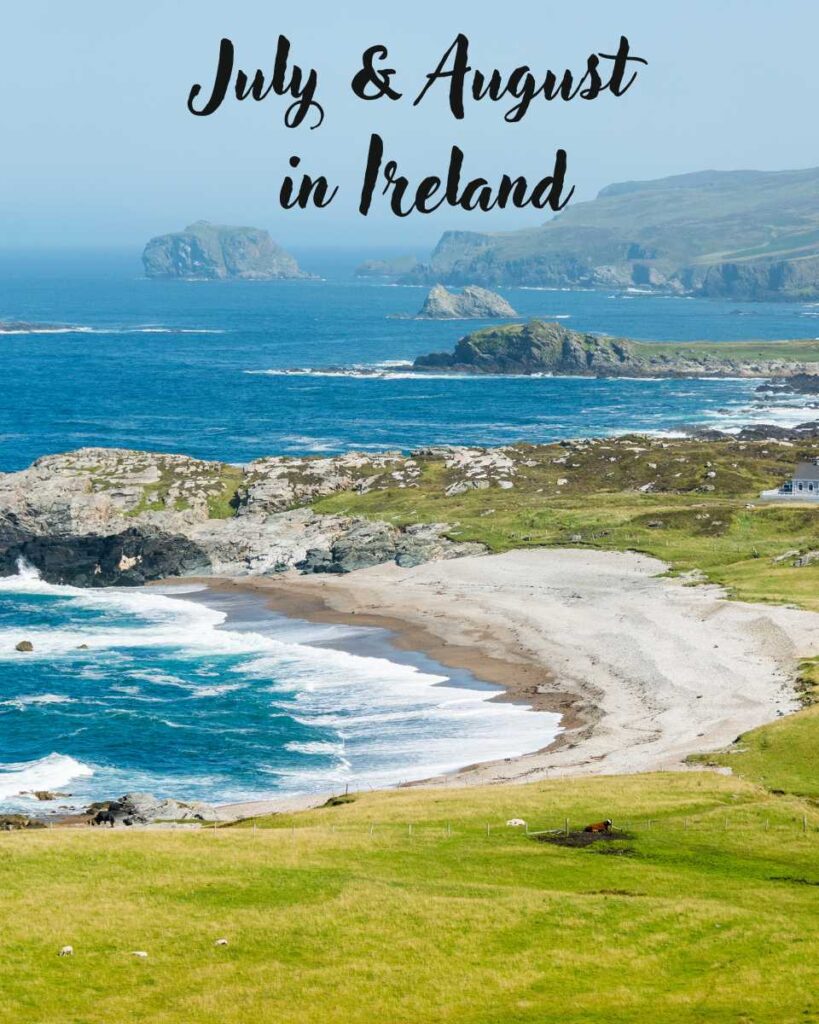
First, let's talk about the weather…
July and August are typically the warmest months in Ireland, with temperatures ranging from 12°C to 18°C (54°F to 64°F).
While it’s not exactly beach weather, it’s certainly pleasant compared to the chillier months. You’ll experience longer stretches of sunshine and relatively mild temperatures, though rain is still a frequent visitor.
And speaking of daylight…
The days are at their longest during these summer months.
In July, you’ll enjoy around 16 hours of daylight, with the sun setting well after 9 pm. By August, the days are slightly shorter, but you’ll still have plenty of light well into the evening. This extended daylight is fantastic for exploring and enjoying outdoor activities.
Crowd levels peak…
By July and August, Ireland is buzzing with tourists. Popular sites like the Giant’s Causeway, the Cliffs of Moher, and Dublin’s attractions can get quite crowded. If you prefer a quieter experience, you might need to plan your visits for early morning or late afternoon. On the flip side, the vibrant atmosphere and numerous festivals can add to the excitement of your trip.
✅ Pros to visiting Ireland in July & August
The warm weather and long days make July and August ideal for outdoor adventures. From hiking in the lush landscapes of Connemara to enjoying boat trips around the Skellig Islands, there’s no shortage of things to do. The pleasant temperatures also make it a great time to explore Ireland’s many gardens and coastal areas.
Summer is festival season in Ireland, with events happening across the country. The Galway International Arts Festival in July is a highlight, featuring theater, music, and street performances. In August, the Dublin Horse Show is a must-see for equestrian enthusiasts, while the Fleadh Cheoil na hÉireann in Mullingar offers a week of traditional Irish music and dance.
🫢 Things to do in Ireland in July & August
These summer months are perfect for taking advantage of Ireland’s outdoor offerings. Head to the coastal towns for seaside strolls, try your hand at surfing on the wild Atlantic waves, or visit one of Ireland’s many beautiful beaches, like Inchydoney or Banna Strand.
The summer weather is also ideal for exploring the charming villages and towns. Take a leisurely drive through the Ring of Kerry or visit the colorful streets of Kinsale. The lively pub scene and outdoor dining options are in full swing, making for a vibrant and enjoyable experience.
If you’re into hiking, the longer daylight hours give you ample time to tackle some of Ireland’s more challenging trails, such as Croagh Patrick or the Wicklow Way. And don’t forget to make time for some relaxing moments in a traditional Irish pub—summer evenings are perfect for enjoying a pint outside.
🎒 What to pack for Ireland in July & August
Packing for Ireland in the summer involves balancing warm-weather essentials with the reality of occasional rain. Lightweight, breathable clothing is key, but also pack a few layers for cooler evenings. A good waterproof jacket is essential, as rain showers can pop up unexpectedly.
Comfortable walking shoes are a must, especially if you plan to explore the countryside or visit multiple attractions. Don’t forget sun protection—sunscreen, sunglasses, and a hat will come in handy during those sunny spells.
With the extended daylight hours, consider packing a reusable water bottle to stay hydrated while you’re out and about.
September & October in Ireland: The Pros & Cons
As summer winds down, September and October offer a unique blend of experiences in Ireland. If you’re contemplating a fall trip, here’s a personal look at what these months have in store and whether they might be the perfect time for you.
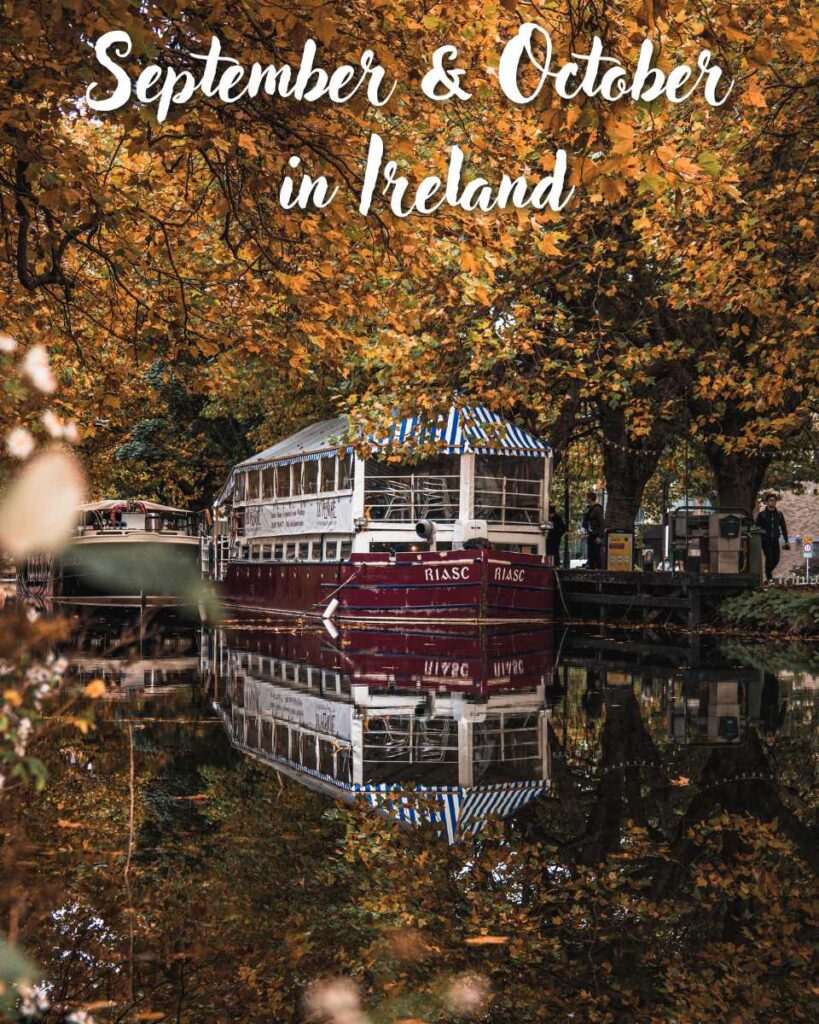
First, let’s talk about the weather…
September in Ireland is like the country’s gentle transition into fall. Temperatures range from 10°C to 17°C (50°F to 63°F), offering a pleasantly mild climate.
By October, things cool down a bit more, with temperatures between 8°C and 14°C (46°F to 57°F).
The weather can be quite variable, with crisp, clear days mixed with some rainy spells, but that’s part of Ireland’s charm.
And speaking of daylight…
By September, you’ll still have plenty of daylight to explore. The sun sets around 7 pm at the start of the month, gradually getting earlier as October progresses. While you might not have those long summer evenings, there’s still ample time to enjoy the beautiful landscapes and attractions before dusk.
Crowd levels ease…
One of the best things about visiting Ireland in September and October is the reduction in crowds. The summer tourists have mostly returned home, and you’ll find the popular sites like Dublin’s Temple Bar area much more manageable. This quieter time allows for a more relaxed and enjoyable experience without the hustle and bustle of peak season.
✅ Pros to visiting Ireland in September & October
September and October are truly delightful months to visit Ireland if you enjoy a blend of pleasant weather and fewer crowds. The autumnal landscapes offer a stunning display of color, with golden leaves and dramatic skies making for fantastic photography opportunities.
Harvest season is in full swing, so it’s a great time to enjoy fresh, local produce. Farmers' markets and food festivals are abundant, showcasing everything from hearty stews to delicious baked goods. Plus, the cooler weather is perfect for cozying up with some traditional Irish comfort food in a welcoming pub.
And here’s a fun fact: Halloween originated in Ireland! The ancient Celtic festival of Samhain, which marked the end of the harvest season and the beginning of winter, evolved into the Halloween we celebrate today. October is a fantastic time to experience this spooky heritage firsthand. Many towns and villages host Halloween festivals with traditional games, storytelling, and eerie tours of ancient sites. Dublin’s Halloween festivities are particularly lively, with parades and themed events that celebrate Ireland’s haunted history.
🫢 Things to do in Ireland in September & October
These months are ideal for exploring Ireland’s natural beauty and cultural offerings. Take a scenic drive through the Irish countryside, where the changing foliage creates a picturesque backdrop. Explore charming towns like Kinsale with its colorful streets and lively atmosphere.
Outdoor enthusiasts will find September and October perfect for hiking. The cooler temperatures make for comfortable trekking, and the autumn colors add an extra layer of beauty to trails like the Devil’s Glen or the trails around Glendalough.
Don’t miss out on the chance to experience some of Ireland’s fun activities like the spookyness of Farmfobia or the Nightmare Realm. October is the perfect time to explore historical sites and castles, like the Rock of Cashel, without the summer crowds.
🎒 What to pack for Ireland in September & October
When packing for Ireland in September and October, think layers! Start with a good base of warm clothing, as temperatures can vary throughout the day. A lightweight waterproof jacket is essential, as you might encounter rain showers.
Comfortable walking shoes are a must for exploring both cities and countryside. Bring a mix of lighter and warmer clothing to adjust to the changing weather. And don’t forget a warm scarf and hat for those chillier evenings—it’s the perfect excuse to enjoy a cozy fireside drink!
November & December in Ireland: The Pros & Cons
As the year draws to a close, November and December offer a cozy and festive charm in Ireland. If you’re considering a winter visit, here’s a personal guide to what these months have in store and whether they might be the perfect time for your trip.
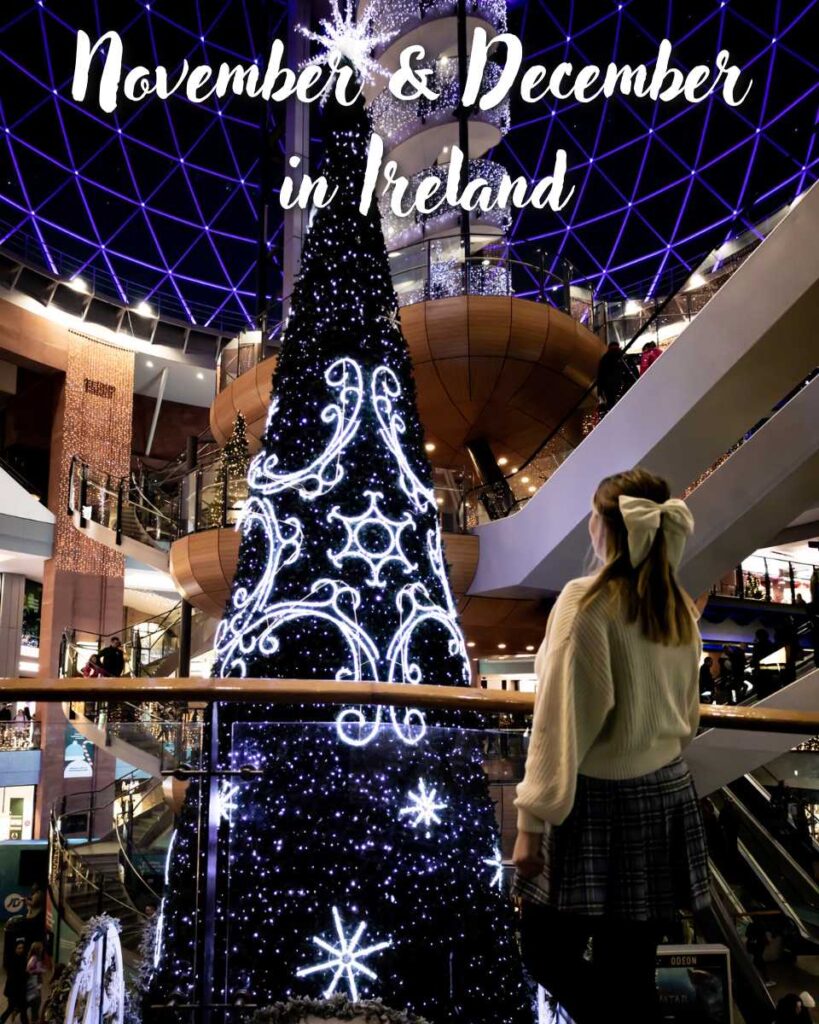
First, let’s talk about the weather…
November in Ireland is typically cool and damp, with temperatures ranging from 5°C to 11°C (41°F to 52°F).
It’s the start of the winter chill, so you’ll need to prepare for some brisk weather and frequent rain.
By December, temperatures can dip even lower, ranging from 2°C to 8°C (36°F to 46°F).
Frost and the occasional snowfall are possible, adding a picturesque winter touch to the landscape.
And speaking of daylight…
Daylight hours are at their shortest during November and December. By early November, the sun sets around 5 pm, and by December, it’s down by about 4 pm. While this means you’ll have less time to explore in the daylight, it also means longer evenings to enjoy Ireland’s cozy indoor activities and festive atmosphere.
Crowd levels drop…
One of the major advantages of visiting Ireland in November and December is the significant drop in tourist crowds. With the peak tourist season behind you, you’ll find popular sites much quieter and more serene. This can make for a more peaceful experience at historical sites and landmarks.
✅ Pros to visiting Ireland in November & December
November and December are perfect for experiencing Ireland’s winter wonderland and festive spirit. The cozy atmosphere is perfect for enjoying traditional Irish pubs, where you can warm up by a fire and savor hearty comfort food. This is also an excellent time for enjoying seasonal treats like mince pies and mulled wine.
December is especially magical with the holiday season in full swing. Ireland is renowned for its Christmas celebrations, and towns across the country light up with festive decorations and Christmas markets. Dublin’s Winter Wonderland and Galway’s Christmas Market are particularly enchanting, offering a festive mix of local crafts, seasonal foods, and holiday cheer.
If you’re a fan of winter scenery, Ireland’s landscapes are stunning with frost-kissed mornings and serene, misty afternoons. The quieter roads and less crowded attractions make for a more relaxed travel experience.
🫢 Things to do in Ireland in November & December
These winter months are ideal for indulging in Ireland’s cozy side. Explore charming towns like Kilkenny or Waterford, where you can enjoy festive markets and local holiday traditions. The Dublin Castle and its Christmas markets are a must-see, and the city’s numerous holiday events add to the festive atmosphere.
For a more serene experience, consider visiting Ireland’s stunning coastal areas. The Cliffs of Moher and the Causeway Coast look breathtaking with winter’s dramatic light and mist. Just be prepared for potentially brisk weather and dress warmly!
Outdoor enthusiasts can still enjoy winter walks in places like the National Botanic Gardens or Phoenix Park in Dublin, where the winter landscape offers a different kind of beauty. And if you’re into history, exploring Ireland’s ancient castles and monuments without the summer crowds can be a unique experience.
🎒 What to pack for Ireland in January & February
Packing for Ireland in November and December requires a focus on warmth and waterproof gear. Layering is essential—think thermal base layers, warm sweaters, and a good insulated coat. Waterproof boots are a must for navigating the often wet and chilly conditions.
A warm scarf, hat, and gloves are crucial for staying comfortable during outdoor explorations. And don’t forget a sturdy umbrella to handle the frequent rain showers. While it might not be beach weather, Ireland’s winter charm makes for a memorable and cozy visit.
Have a Ireland Travel Question?
Then join my FREE Facebook Community, I pop in once a week to answer as many queries as possible. Please do not email or DM. It is easier for me to manage everything in the one place 😊
👋 JOIN MY FREE IRELAND FACEBOOK COMMUNITY
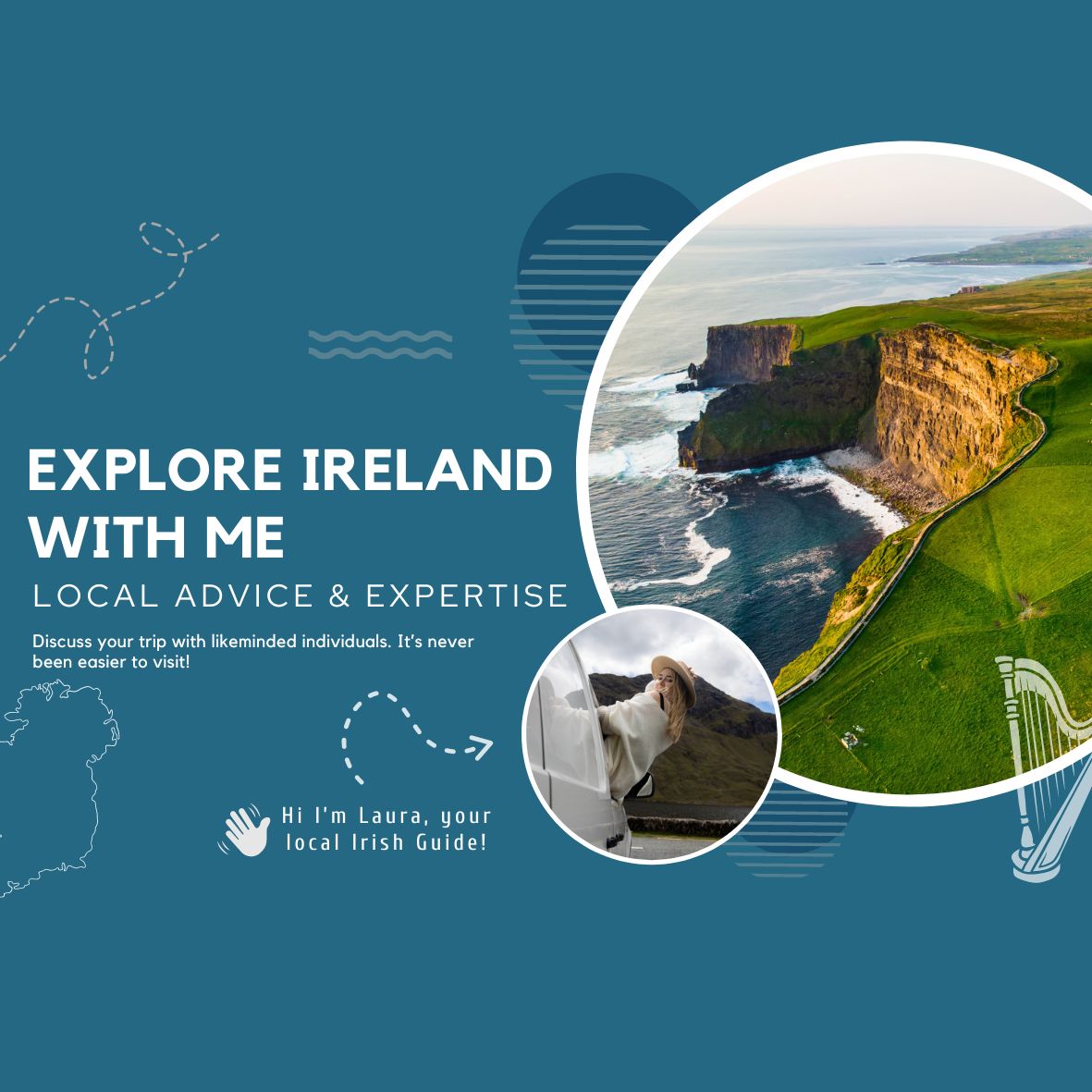
🇮🇪🇮🇪🇮🇪
FREE IRELAND FACEBOOK COMMUNITY
✔️ LOCAL ADVICE
✔️ FREE ACCESS TO GOOGLE MAPS PINS
✔️ GROUP DISCUSSION

